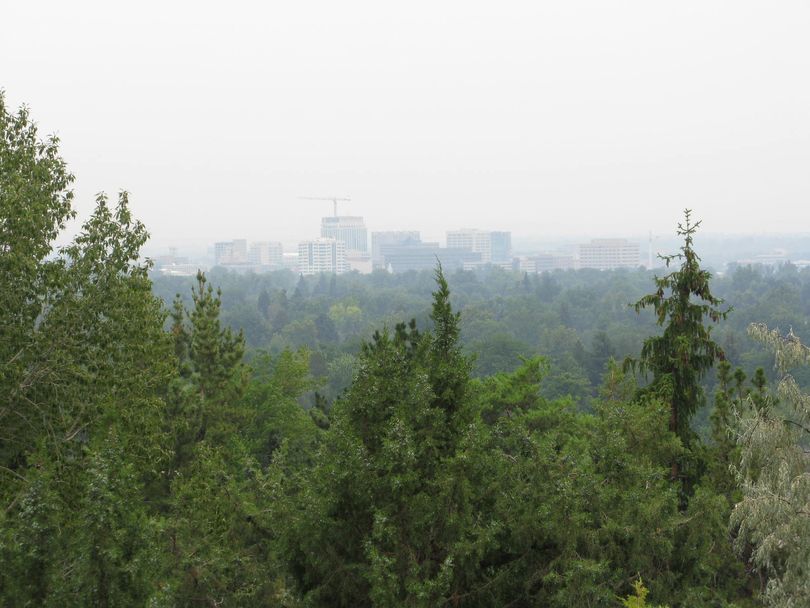Smoke socking in mountain valleys, H&W advises limiting outdoor activity

Yep, it's looking awfully smoky out in Boise, and now comes this word from the Idaho Department of Health & Welfare: Air quality in some parts of the central Idaho mountains has reached the "unhealthy" or "unhealthy for sensitive groups" level, and they're alerting people to limit outdoor activity. "The Department of Environmental Quality (DEQ) is forecasting unhealthy levels for areas of Boise, Elmore, Blaine, Camas and Custer counties," H&W says in a news release. "Because of wildfire activity and weather patterns, air quality conditions are not expected to significantly improve through this week." Click below for the full H&W announcement, which also advises drinking plenty of water, avoiding heavy work or exercise outdoors when air quality hits unhealthy levels, and taking care for the very young or old and those with respiratory conditions.
Boise was only predicted to be moderate today, but Mary Anderson, smoke management program coordinator for the DEQ, said, "Based on visibility downtown, it's more likely into the unhealthy for sensitive groups or possibly in some areas unhealthy. The closer we get to kind of where the smoke is coming down from the mountains is where it's the unhealthy."
Anderson said the DEQ issued a Stage 1 air pollution forecast and caution today after monitors in Idaho City, Garden Valley, Ketchum, Lowman, Atlanta and Challis all went into the unhealthy or unhealthy for sensitive groups zone. "It's basically from the Elk Complex and Pony Complex fires," Anderson said. "They're heading north. ... Basically all the mountain valleys are getting impacted. It's pretty widespread." Idaho's interagency smoke blog has been activated here; it has links and info on smoke impacts.
www.healthandwelfare.idaho.gov
NEWS RELEASE--FOR IMMEDIATE RELEASE
Air quality in central Idaho mountains now designated unhealthy
because of fires
Outdoor activities should be limited in those areas, public health officials say
Air quality in some central Idaho mountains has reached an “Unhealthy for sensitive groups” or “Unhealthy” designation, and the Idaho Department of Health and Welfare’s Division of Public Health is alerting people to limit outdoor activity. The Department of Environmental Quality (DEQ) is forecasting unhealthy levels for areas of Boise, Elmore, Blaine, Camas and Custer counties. Because of wildfire activity and weather patterns, air quality conditions are not expected to significantly improve through this week.
People exposed to smoke may experience symptoms such as coughing and shortness of breath. Older adults, infants, children and people with medical conditions such as asthma, chronic obstructive pulmonary disease, and heart disease are often more affected. People who use inhalers for asthma or other conditions should keep them close at hand. People are advised to seek medical treatment for uncontrolled coughing, wheezing, choking, or if they have difficulty breathing once they move back indoors.
To reduce your exposure to smoke and protect your health, public health officials advise:
· Everyone should avoid heavy work or exercise outdoors when the air quality index reaches unhealthy levels.
· Older adults, small children, and those with respiratory conditions or heart disease may be more sensitive to poor air quality and should stay indoors and avoid heavy work when air quality reaches unhealthy levels.
· Drink plenty of water. Staying hydrated helps dilute phlegm in the respiratory tract, making it easier to cough out smoke particles. Plan on coughing; it is nature’s way of clearing your lungs. Avoid caffeine products, sugary drinks and alcohol because they have a dehydrating effect.
· Stay cool if the weather is warm. Run your air conditioner to recirculate air. Turn the fan blower on manually so it continuously filters the air in your home.
· For homes without a central heating and/or cooling system, use portable air purifiers to remove particles. Air purifiers that utilize HEPA filters are best; avoid using air purifiers that produce ozone. Visit areas in your community that have air conditioning, such as a library.
· If you wear contact lenses, switch to eyeglasses in a smoky environment.
Not all areas of the state have air quality monitors, so people are encouraged to be cautious if visibility is affected because of smoke and particulates from wildfires. If visibility is reduced to less than eight miles, sensitive groups should limit activity. If visibility is reduced to less than three miles, air quality is considered unhealthy for everyone.
Daily updates on air quality conditions at various locations in Idaho are available on DEQ's Air Quality Reports and Forecasts webpage. For areas where air quality monitors are not available, the Visibility Range and AQI Table can help determine the necessary precautions to take. For more complete information about wildfires in your area visit the Idaho Smoke Information Blog.
For more information on protecting your health from wildfire smoke, visit Idaho Department of Health and Welfare’s Wildfire Smoke and Your Health webpage.
